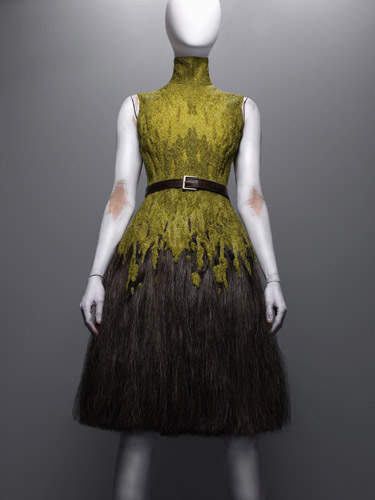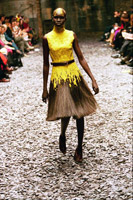Alexander McQueen (British, 1969–2010)
Dress
Eshu, autumn/winter 2000–2001
Yellow glass beads and brown horsehair
Courtesy of Alexander McQueen
Photograph © Sølve Sundsbø / Art + Commerce
Audio clip: Adobe Flash Player (version 9 or above) is required to play this audio clip. Download the latest version here. You also need to have JavaScript enabled in your browser.
Andrew Bolton: The 2001 collection Eshu was inspired by the Yoruba people of West Africa, mixing tribal details with luxurious fabrics. This dress, embroidered with yellow glass beads interwoven with horsehair, is a tour de force of the couture. McQueen contrasts the sophistication of the beading with the rawness of the hair. Sarah Jessica Parker:
Sarah Jessica Parker: I described his clothes once—and I hope this isn’t offensive—but they were like sometimes ugly-beautiful. You couldn’t just call them “beautiful” because it seems like saying, “It’s fine. You know, the dinner was fine. You know, the clothing was lovely. They were lovely.”
But I think it’s this sort of raw sex of his clothes with the very unusual androgyny, an attempt at that at the same time. He kind of married these opposites—these sort of contrasting ideas—you know. A very high neck, which is very, very hard to wear. It’s not particularly sexy. But because the fabric was so close to the body, everything hugged in a really amazing way. You would tend to consider a high neck where you mightn’t with anybody else’s, because it still felt really sexy.
In McQueen’s Words
“[I try to] push the silhouette. To change the silhouette is to change the thinking of how we look. What I do is look at ancient African tribes, and the way they dress. The rituals of how they dress. . . . There’s a lot of tribalism in the collections.”
Purple Fashion, Issue 7, Summer 2007


 Vogue iPad app
Vogue iPad app
